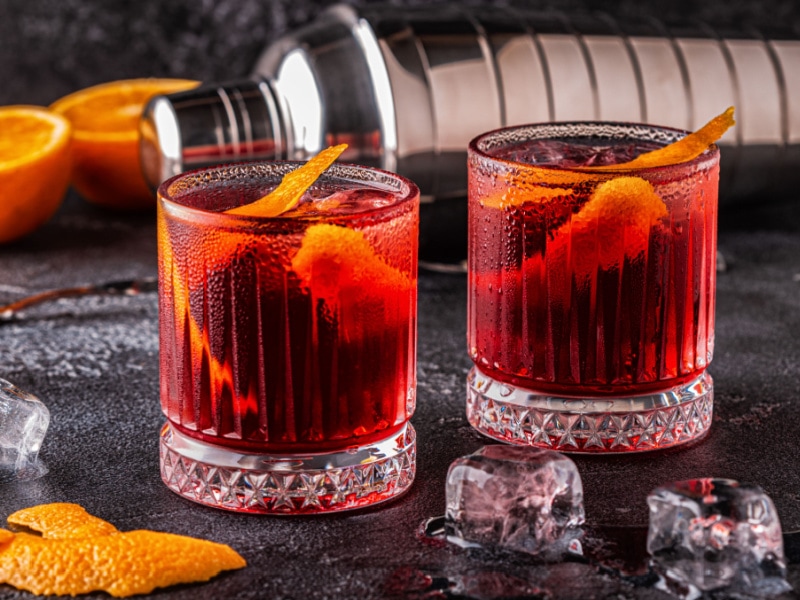What’s the difference between Campari and Aperol? The two vary in flavor, color, ingredients, and alcohol content.
These two spirited liquors, born in Italy, are known worldwide for their vivid colors and distinctive tastes.

You’ll find them on nearly every bar menu. But what sets them apart? Is one better than the other?
Let’s explore their origins, flavors, and best uses in our favorite beverages. You’ll be ready to impress at your next cocktail party!
Campari vs. Aperol (What’s the Difference?)
Let’s dive into what makes these two iconic Italian aperitifs different!
Origin
Northern Italy is the birthplace of the aperitivo culture we know and love today.
Back in the 1800s, local taverns across this region each had their unique aperitivo.
Bartenders came up with their custom blends, resulting in a wide range of tastes from sweet to bitter to herbal.
But then came Gaspare Campari in 1860, who formalized the aperitivo game with his creation, Campari Bitter. He sold it in his bar in Milan, and it quickly became a hit. Then, when his son Davide took over, he opened his own bar, and the Campari legacy continued.
Now, Aperol’s journey is a different story. Brothers Luigi and Silvio Barbieri created it in 1919 in Padua, Northern Italy.
It took them 7 whole years to get it just right. And after World War II, it became a big hit. Aperol even inspired the popular Aperol Spritz cocktail in the 1950s.
Ingredients
Want to whip up your own Campari? Well, the official recipe is a guarded secret.
But here’s a hint: gather some bittering agents like roots, herbs, and edible flowers, along with a mix of botanicals. It’ll mimic the distinctive flavor.
The red color once came from squished cochineal beetles (no joke), but nowadays, it’s all about red food coloring.
Now, let’s talk about Aperol. Some not-so-secret ingredients include orange oil, gentian, rhubarb, and cinchona.
But like Campari, the official recipe is kept hush-hush.
Color
One look at these drinks, and you’re instantly drawn in by their vibrant colors. Campari paints a picture of a crimson sunset.
As I mentioned before, the fiery red color came from a dye extracted from cochineal insects.
But since 2006, the company’s been using artificial coloring. Interestingly, some countries still use the cochineal dye since it doesn’t ruin the flavor.
On the other hand, Aperol is all about the bright orange.
Flavor
Campari’s deep red tone is a teaser of its robust flavor, bitterness, and alcohol content. A big chunk of its bitter kick comes from citrus peel, herbs, and a blend of warm spices and cherries.
On the flip side, Aperol’s orange flavor really stands out. You’ll also catch hints of botanicals and rhubarb. It’s also less bitter than Campari.
Alcohol Content
Campari is the stronger of the two, with an alcohol by volume (ABV) of 24% compared to Aperol’s 11%.
However, Campari’s ABV can shift between 20-28% depending on where you are. Aperol usually sticks to 11%, except in Germany, where it’s a sturdier 15%.
But remember, both are still less alcoholic than spirits like gin, tequila, or vodka, which all clock in at around 40%.

How to Use Campari
Campari is great for cocktails that need depth, body, bitterness, and a dash of sweetness in their mix.
It has rich, deep herbal and orange peel flavors, making it a great sidekick for potent spirits like herbaceous gin and sweet bourbon.
You’ll often find Campari in a Negroni. This is a gutsy cocktail with equal parts Campari, gin, and sweet vermouth.
If you’re new to its bold bitter notes, tame them with some ice. It’s the perfect beginner’s hack.
Want an easy alternative? Mix one part Campari with two parts soda over ice. Then, crown it with an orange slice, and voilà, you’re all set to sip and savor!

How to Use Aperol
When you mention Aperol, the first thing that pops up is the Aperol Spritz. The legendary cocktail is a breeze to make.
Just mix Aperol, Prosecco, and club soda, and toss in a big chunk of orange. Not only is an Aperol Spritz the perfect cool-down drink, but it really lets Aperol’s charms shine.
The bubbles give life to its citrusy smells, and the sweetness of the Prosecco is the perfect sidekick to those bitter notes.
And guess what? Aperol is also best buddies with other fruity flavors. Its sweetness adds a nice counterpoint to sweet-sour fruits and gives a bittersweet spin to any juicy fruit.
Can You Swap Aperol for Campari or Vice Versa in Cocktails?
Wondering if you can swap Aperol and Campari in your cocktails? Well, technically, you could. But remember, you’ll end up with a drink that’s quite different from what you started with.
Even though they’re similar, they’re also pretty different in bitterness, sweetness, and botanical flavors.
So, switch ’em if you like, but know that it’ll give your cocktail a fresh twist.
Which Is Better for a Negroni?
Campari really shines in a Negroni. Its mix of bitter, botanical, and gently sweet tastes snuggles up perfectly with gin and sweet vermouth. It’s simply the best choice for this cocktail!

Campari vs. Aperol (Which Is Better?)
Let’s put it this way: neither is better. It all boils down to what you prefer taste-wise and how much of a kick you want from the alcohol.
Sure, one might be a better match for certain cocktails, but they’re pretty flexible. You can try them both and enjoy them in many different ways. It’s all up to you, really!










